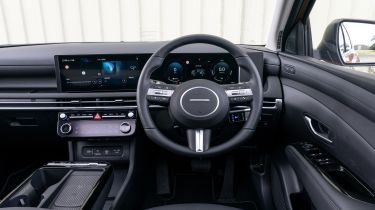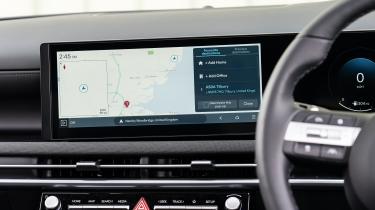Hyundai Tucson - Interior, design and technology
Cabin quality for the Tucson is a huge step forward and a match for some premium SUVs

When this generation of Hyundai Tucson arrived, it certainly marked a departure from its more conservative forbear to stand out in the highly competitive medium SUV class.
The designers of the revised Tucson have wisely chosen not to tone down its attention-grabbing exterior. The only changes of note are a new grille at the front and a more prominent lower portion of the bumper that includes a faux skid plate to bolster the car’s chunky SUV look. At the back, the Hyundai badge is now behind the glass of the back window, which looks much tidier.
Manufacturers across the board are raising their game when it comes to interior design and levels of onboard tech, and the Tucson is no exception. We were impressed by the premium feel of the interior before, but the design has been dramatically altered with the facelift to give it a look more in keeping with the cabins of the smaller Hyundai Kona and electric Hyundai Ioniq 5. The digital driver’s instrument cluster and central infotainment screen now flow into one another across the dashboard, while underneath the central screen are a series of physical shortcut buttons that are much easier to get on with compared with the touch-sensitive controls of the pre-facelift car.
Used - available now

2020 Hyundai
Tucson
29,213 milesAutomaticPetrol1.6L
Cash £14,800
2023 Hyundai
Tucson
17,785 milesManualPetrol1.6L
Cash £21,700
2023 Hyundai
Tucson
55,269 milesAutomaticPetrol1.6L
Cash £19,587
2023 Hyundai
Tucson
29,517 milesManualPetrol1.6L
Cash £19,487Below them are the climate controls which feature a pair of sizable dials that control the temperature for each front zone, which are much easier to find while driving than the touch-sensitive controls of the outgoing Tucson. The virtual buttons on a screen between the two dials are still touch-sensitive, although you shouldn’t need to interact with them often. The only major downside is that you’ll need to stretch more in order to reach the far corner of the central screen since it’s positioned further away.
The solid feel of the previous Tucson carries through to the revised model, although our previous note of a sombre colour palette for most trim levels remains, despite the odd strip of fabric across the dash to break up the expanse of soft-touch plastic.
Once you’re sitting in the driver’s seat, you’re faced with a smart 10.25-inch digital instrument cluster and a clean, simple layout with only a few physical buttons and switches. Cars with a manual gearbox have a different centre console design, while automatic models follow the aforementioned Kona and Ioniq 5 in using a gear selector mounted just behind the steering wheel on the right, freeing up more storage space.
Standard equipment is generous, with the entry-level Advance trim including 17-inch alloy wheels, dual-zone climate control, cruise control, a rear-view camera, front and rear parking sensors, heated and folding door mirrors and the usual Bluetooth, wireless smartphone connectivity with a wireless charging pad, and DAB audio set-up.
Upgrading to Premium adds an electric tailgate, an upgraded Krell audio system, a heated steering wheel, heated front and rear seats, along with extra active safety features such as an autonomous emergency braking system that prevents you from turning into the path of oncoming traffic at a junction, and adaptive cruise control to automatic and hybrid models
N Line and N Line S models introduce a few sporty touches to the fourth-generation Tucson, both inside and out. The standard N Line mirrors much of what you get with Advance, but adds 19-inch alloy wheels, a reprofiled front bumper with larger intakes and a more aggressive rear diffuser with twin-exit exhausts. Buyers also get a tailgate spoiler and a fresh radiator grille, plus an N-branded steering wheel, black headlining, aluminium pedals and a pair of sports seats trimmed in black suede and leather for the cabin.
N Line S trim gets the same styling tweaks, but extends the kit list to include three-zone climate control, a heated steering wheel, ventilated front seats, an electric panoramic sunroof, a 360-degree camera system, LED matrix head lights, as well as a Blind Spot Collision Warning system.
Those who don't want a sporty-looking Tucson but want the gadgets fitted to N Line S will need to go for the top Ultimate trim, which adds driver’s seat memory settings and the availability of alternative seat colours.
Sat-nav, stereo and infotainment
The Tucson has a very impressive infotainment system that’s intuitive and straightforward to operate. Every model features a pair of 10.25-inch screens that offer fast loading times and clear graphics, plus built-in sat-nav (which works well), along with Apple CarPlay and Android Auto if you would prefer to link up your smartphone.
The central touchscreen might not match the display sharpness or loading times of the Renault Austral’s Google-powered set-up, nor is it as big as the one in the Kia Sportage, but it’s still clear and easy to read. The main menu displays all of the key features in two rows of shortcut icons, and most of the sub-menus are fairly well thought out.
Hyundai has improved navigation to the driver-assistance menu, which is a blessing considering that the car can seem like it’s beeping at you incessantly as you’re driving along. You used to have to delve into various menus within the touchscreen, but now there’s a shortcut button on the steering wheel that sends you straight to the correct menu. There’s also a secret shortcut to deactivate the speed limit warning (a system that beeps when it detects you’re exceeding the speed limit) where you simply press the mute button for a few seconds to silence the system.
A second 10.25-inch display sits ahead of the driver. The stats are easy to select via steering wheel-mounted buttons, and the colours and graphics adjust based on the chosen driving mode.
If you enjoy listening to music in your car, the upgraded Krell stereo available with Premium, N Line S, and Ultimate trims is worth considering.









